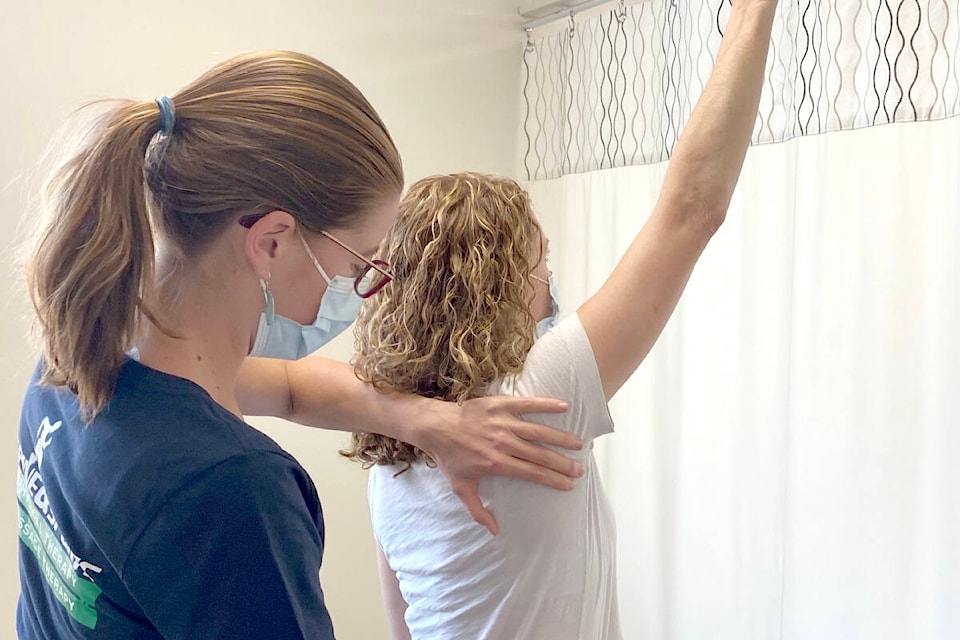Frozen shoulder is not a cool problem to have.
If you can’t tuck your shirt in, do your bra up, reach for the chips on the top shelf or lay on your shoulder you may have a frozen shoulder (also called adhesive capsulitis, but that is boring). It is a common disorder that causes pain, stiffness, and loss of normal motion in the shoulder. The pain can be in the shoulder or can radiate into the upper arm.
At rest the shoulder doesn’t usually hurt. But when moving it in specific directions the pain can be extreme and jolts into the arm. It often stops the person cold. There is an audible wince and immediate need for the person to rub their arm vigorously. This is a classic pain response from someone with a frozen shoulder. The condition tends to get worse with time if it’s not treated.It can seem elusive, but it doesn’t need to be.
So what does “freezing” of the shoulder mean exactly? And what are your steps to “defrost” it ? Read on…
How does the shoulder become frozen?
This disorder usually begins with an injury. Overuse activities such as pruning your trees all weekend, too much backyard “catch” with the kids or lifting your kayak on and off the car roof can set the stage for injury.
It can also start from a traumatic injury such as a fracture or dislocation and subsequent use of a sling or disuse. This sets the perfect breeding ground for the shoulder to start chillin’. It’s the inflammation that causes the pain which gets worse with movement.Then the connective tissue ( joint capsule) surrounding the glenohumeral joint thickens and contracts, losing its normal capacity to stretch.
Trying to avoid the pain caused by moving the shoulder leads to further contraction of the capsule. The ball and socket joint now has less space to move in and the joint loses its lubricating synovial fluid. It’s like the Tin Man in “The Wizard of Oz.” Oh to just have the quick fix of a can of oil. Tin Man had it so good!
Who gets a frozen shoulder?
It affects mainly people ages 40 to 60 — women more often than men. The risk is increased when you don’t receive physiotherapy after an injury and the inflammatory process is left to go bananas. About 10 per cent of people with rotator cuff disorders will develop a frozen shoulder.
It also can freeze up nicely when a sling is worn for more than a few days without intermittent stretching. Enforced immobility resulting from a stroke, heart condition or surgery may also result in a frozen shoulder. Other conditions that raise the risk are thyroid disorders, Parkinson’s disease and diabetes (frozen shoulder affects 10-to-20 per cent of people with diabetes).
What to do?
If you think you have a frozen shoulder see your physiotherapist for a physical exam. Diagnosis is usually very easy and fancy imaging diagnostics are not needed. Frozen shoulders have a unique and unmistakable presentation in the clinic.
Treatment is focused on relieving pain and restoring the shoulder’s normal range of motion. Heat should be applied to the shoulder for 10-to-15 minutes several times a day. A regime of anti-inflammatory medications are useful if you are in the early, painful stage. You also may be given a corticosteroid injection into the shoulder joint.
But the cornerstone of treatment is physiotherapy, concentrating first on exercises that stretch the joint capsule, and later, on strengthening exercises. A physiotherapist can show you how far to push yourself and can teach you the appropriate exercises.
As you work to stretch the shoulder capsule, you should avoid any activities that require overhead reaching, lifting, or anything else that aggravates your pain. If you let your physio boss you around with shoulder exercises full recovery is expected. However it takes time. You have to be a “patient” patient to thaw a frozen shoulder. There is no quick and easy fix. If you don’t move it, you lose it.
Cheryl Witter is a physiotherapist and the owner of Spine and Sports North End Physical Therapy and Massage Therapy
READ MORE: COLUMN: Vernon physiotherapist assists with post-COVID-19 rehab
READ MORE: PHOTOS: Vernon physio clinic reaches quarter-century milestone
Like us on Facebook and follow us on Twitter.
Want to support local journalism? Make a donation here.

